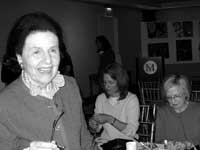
Muriel Silberstein-Storfer:
Art Educator Par Excellence
by Sybil Maimin
Parent-child art studio workshops under the guidance
of Muriel Silberstein-Storfer have become an institution in
New York City, whether experienced in the august and inspiring
environment of The Metropolitan Museum of Art, the new JCC
(Jewish Community Center, at Amsterdam Avenue and 76th Street),
at schools and institutions in the five boroughs via Doing
Art Together, a program that brings instructors and methods
into the community, or via the CD-ROM “Look What I.C.,” which
provides demonstrations and instructions for hands-on art activities
at home. At The Met recently, Silberstein-Storfer spoke warmly
with an admiring group of teachers, former and present students,
and museum members about her philosophy, career hallmarks,
and mentors. She gave much credit to Victor d’Amico,
her art teacher at Fieldston High School and later head of
The Museum of Modern Art’s Institute of Modern Art where
she first became an art teacher. “He changed my life
in so many ways,” she explained. He taught that art should
not be thought of as a separate area of study but should be
integrated in all areas of life. She has been a forceful advocate
of the importance of arts in education and the need for people,
especially young children, to be made aware of their senses.
She is constantly touched and inspired by nature and encourages
the use of found materials and expression of feelings. Another
mentor was Jane Cooper Bland, her first teacher in a parent-child
workshop, who taught, “A teacher should never have a
preconceived idea of what she wants from a child...An art experience
must be personal. It must express a child’s own ideas,
from his own experiences, imagination, or from the materials…Children
see the world with different eyes than do most adults.” Today,
Silberstein-Storfer has a rewarding relationship with and much
praise for Electra Askitopoulos Friedman, co-founder of Doing
Art Together.
The Chinese proverb “What I hear I forget.
What I see I remember. What I do I know.” instructs Silberstein-Storfer’s
teaching philosophy. In her workshops, as children and parents
(working separately) progress from projects with paint, then
collage, then clay, “You can hear a pin drop. It’s
like a spiritual temple. Everybody is so busy working,” explains
Eileen Travell, a former student who now attends with her three-year
old daughter. Hoping that “parents and children will
become culturally literate and pick up ideas and inspiration,” Silberstein-Storfer
fills her classroom with reproductions of famous art as well
as works by the children, encourages visits to museums and
galleries, and utilizes art books. Her favorite book, Little
Blue and Little Yellow by
Leo Lionni, focuses on color and shows how blue and yellow
characters hugging each other can produce a new hue. The children
learn “to draw with scissors” as they “cut
lines,” talk about archways as “see-through shapes,” and
discover that “there is nothing you can do that nature
didn’t think of first.” An aesthetic vocabulary
around color, line, form, and texture is inculcated.
The CD-ROM, produced
by Rori Jones and designed for children aged 3 to 10, contains
layers of material and links. It includes demonstrations,
suggestions for all kinds of activities, classroom views,
and lots of information and tips. It shows how to replicate
the art studio workshops at home or other settings. As proclaimed
by Muriel Silberstein-Storfer, “Everything
is possible in art.”#
